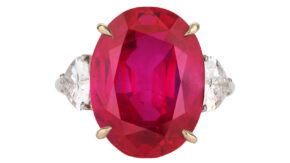A look at the ever-growing practice of consignment and the benefits it offers jewelers.
Much of the jewelry trade relies on memo — short for memorandum, a reference to the paper trail used to keep track of goods. It’s the industry’s version of consignment, whereby vendors and suppliers loan goods to stores on an as needed basis.
“Memo has been around since the dawn of the jewelry business,” says Doug Hucker, CEO of the American Gem Trade Association (AGTA). “Everyone can’t have all the inventory they need, and so you look to your suppliers to give you memo. There’s no inventory cost to the jeweler, and then they sell the piece and pay the supplier.”
In the past, memorandum goods were a more fragmented affair for both vendors and retailers, according to Andrew L. Rickard, vice president of operations at New York-based wholesale distributor RDI Diamonds.
“It used to be primarily out of New York, and there were road warriors who would travel across the country and sell things. Then FedEx created overnight shipping. Before, if I was in Idaho, there was no method to get the item I needed. Overnight shipping helped memo evolve. Now, companies like RDI Diamonds are willing to provide diamonds on consignment. That means stores don’t have to extend that capital, and they can use our inventory as bank. They show them, sell them and return what doesn’t sell.”
Cross-category appeal
Loose diamonds and colored gemstones are popular memo categories. “In the colored-stone business, there’s more memo in the high end, because of the limited ability of a retail jeweler to spend $1 million on colored stones,” says Hucker. “Also, if a customer comes in looking for a 15-carat tourmaline, the chances of you having that in stock are small. So a lot of colored-stone dealers are willing to memo out goods.”
And although memo touches almost every jewelry category, not all companies need it or use it. Larger vendors and those in high demand, such as Rolex, are unlikely to utilize this option, because they’re better able to set high prices and require large buy-ins.
Still, states Rickard, “memo is pretty pervasive throughout the industry. There are firms in every category that do some form of memo, although certain organizations have different rules on what they’ll allow.”
Pros and cons
Naturally, there are benefits and drawbacks to the arrangement. “Memo is a difficult business for vendors, even short-term,” Rickard acknowledges. “Memo is just a chance. To a large degree, I try and get you the best I can, and then hope you sell it. But the value that memo provides to retailers is huge. And when vendors develop a partnership with a retail client, we both get the benefit.”
For some stores, though, the drawback is price. “There are some downsides for retailers,” he continues. “Smart wholesalers are charging them more. So if you’re quoting off a higher price, you’re charging a higher price, unless you’re reducing your markup. But retailers are willing to look past the higher price, because it’s free up front.”
‘As popular as ever’
By most accounts, the use of memo is expanding. But that doesn’t mean it’s more desirable, according to Hucker. “A lot of jewelers need the support, but if you talk to suppliers, they say they’d like to sell it and get paid for it right away.”
That said, even with long-term memo, vendors see the benefit. “Short-term memo is as popular as ever and probably growing,” says Rickard. “And although I’ve started to see less long-term memo, there are still people who will do that just to get their foot in the door. It’s a hell of carrot for a retailer to offer.”
The Basics of Memos
Decades ago, many jewelers owned most of what was in their cases, although even then, memo was a small part of doing business.
In recent times, however, retailers have found that having goods on consignment is an increasingly convenient way to keep their stock fresh without costly inventory overhead.
- What is it?
In essence, memo is a loan from a vendor to a store. It gives the vendor or supplier the opportunity to have its merchandise out at retail, and not gathering dust in a vault.
For jewelers, it means the chance to feature loose diamonds, gemstones, and finished pieces without having to spend a lot of money up front, since there is no charge on memo goods until the item is sold.
- When is it used?
Short-term: When a retailer needs to fill immediate gaps in inventory, such as when customers make requests, it can call a vendor to order specific stones or finished pieces.
The vendor will ship the item, and if the sale isn’t completed within a specific period (normally one to two weeks), the retailer returns the product.
Long-term: This is for when suppliers want a foot in the door, or when a retailer wants to showcase merchandise that may not be in immediate demand.
Long-term memo typically lasts anywhere from 30 days to six months, and allows vendors to place items in-store with no risk to the retailer.
The vendor assumes the risk, since there’s no guarantee the goods will sell.
- Risk management
As there is no up-front financial commitment, the system relies on vendor-retailer trust.
Retailers often pay a higher price and therefore have smaller margins on these goods, which is how vendors offset the risk of sending products without payment.
Both stores and suppliers are required to keep track of sales and returns, with retailers reporting weekly on what they sell and what they return to the vendor.
Image: Shutterstock




